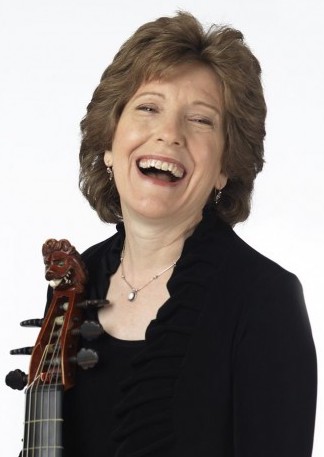When Lisa Terry joined Tempesta di Mare as principal cello this fall, Tempesta didn’t just get a new cellist. They got a whole new world of looking at low strings. Audiences will be able to appreciate it when she plays in the upcoming Bach Trio Sonatas show.
Terry has a distinguished career in baroque and classical cello. But she’s also well known for her work on that other big, bowed historical instrument that you play between your legs, the viola da gamba.

Viola da gamba, a.k.a. “viol,” is a renaissance and early baroque instrument, and Terry is one of the notable practitioners who have helped bring it back to life in modern times. She has been a mainstay of period music groups such as New York’s Parthenia and ARTEK, of which she was a founding member. Philadelphia audiences recognize her from guest appearances with Piffaro, the Renaissance Band. (She’s been a section cellist in Tempesta’s orchestra for the past two seasons, too.)
Being a gamba specialist as well as a cellist gives Terry unique insights into playing Bach. She gets to see Bach back-to-front:
“I always hear, when I play Bach, what he’s referencing, because I’m very well steeped in the music of the 16th and 17th centuries that he learned and draws from. It’s counterpoint, and it’s voice-leading, and the way he lets the instruments have layer and texture that’s so different from later composers, even composers of his same age.”
A tiny woman with snapping bright eyes, wide gestures and an infectious laugh, Terry exudes passion and geekdom in equal measure. Here she is on the subject of musicians who can only look backward, not forward when they play baroque:
“My biggest quibble with most cellists’ renditions of Bach is that they have this long tradition of playing cello and no idea what the history of the music development is,” she says. “When I talk to modern cellists about the Bach cello suites, I say, ‘Don’t listen to cellists play these.’ I say, ‘Listen to a keyboard player play Froberger, listen to a lute player play something from 1600, study the development of the suite….’
A tiny woman with snapping bright eyes, wide gestures and an infectious laugh, Terry exudes passion and geekdom in equal measure.
“‘…And just play the damn allemande. Don’t get all self-indulgent about it, just play a dance movement!’”
In the ‘80’s and ‘90’s, Terry’s major focus was viol. But she never stopped playing cello, for instance playing both viol and cello in the chamber group, Princeton’s Dryden Ensemble. Ten years ago, cello started to beckon more insistently. Terry found herself seriously searching out cello repertoire, launching into “heavy-duty” cello practicing, and refining her solo technique.
And letting her instruments cross-pollinate:
“Sometimes I play cello with a viol grip, underhand.” She mimes holding the bow underhand like a shovel, not overhand like a rake. “With the underhand grip, I can get a sound that’s more like a viol—more blended, transparent, a lot of front to the note.” She hums, a low, unobtrusive tone. “It’s a sound that doesn’t get in the way of anything, it’s sustained but it’s clear, you can completely hear someone else’s figuration through it. That’s what I want to do sometimes, not to get too interesting until the music asks for it.”
Becoming part of Tempesta lets her do something she’s wanted to do for a quite a while, lead a cello section in a big ensemble. “This is a huge shift for me! Playing cello in an orchestra is something I haven’t done since I was in Concert Royal in New York, and they’ve been largely defunct since 2000,” says Terry. “I’m delighted to be here. It’s such a great group. I’m having a blast!”
Anne Schuster Hunter is a writer and art historian living in Philadelphia.
